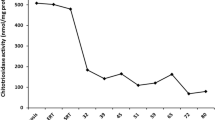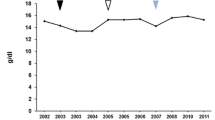Abstract
Gaucher disease is caused by a deficiency of the lysosomal enzyme glucocerebrosidase (acid β-glucosidase), with consequent cellular accumulation of glucosylceramide (GL-1). The disease is managed by intravenous administrations of recombinant glucocerebrosidase (imiglucerase), although symptomatic patients with mild to moderate type 1 Gaucher disease for whom enzyme replacement therapy (ERT) is not an option may also be treated by substrate reduction therapy (SRT) with miglustat. To determine whether the sequential use of both ERT and SRT may provide additional benefits, we compared the relative pharmacodynamic efficacies of separate and sequential therapies in a murine model of Gaucher disease (D409V/null). As expected, ERT with recombinant glucocerebrosidase was effective in reducing the burden of GL-1 storage in the liver, spleen, and lung of 3-month-old Gaucher mice. SRT using a novel inhibitor of glucosylceramide synthase (Genz-112638) was also effective, albeit to a lesser degree than ERT. Animals administered recombinant glucocerebrosidase and then Genz-112638 showed the lowest levels of GL-1 in all the visceral organs and a reduced number of Gaucher cells in the liver. This was likely because the additional deployment of SRT following enzyme therapy slowed the rate of reaccumulation of GL-1 in the affected organs. Hence, in patients whose disease has been stabilized by intravenously administered recombinant glucocerebrosidase, orally administered SRT with Genz-112638 could potentially be used as a convenient maintenance therapy. In patients naïve to treatment, ERT followed by SRT could potentially accelerate clearance of the offending substrate.






Similar content being viewed by others
Abbreviations
- CNS:
-
Central nervous system
- ERT:
-
Enzyme replacement therapy
- ESI/MS:
-
Electrospray ionization mass spectrometry
- GD:
-
Gaucher disease
- GL-1:
-
Glucosylceramide
- H&E:
-
Hematoxylin and eosin
- HPLC:
-
High-performance liquid chromatography
- NB-DNJ:
-
N-butyl deoxynojirimycin
- SRT:
-
Substrate reduction therapy
References
Aerts JM, Ottenhoff R, Powlson AS et al (2007) Pharmacological inhibition of glucosylceramide synthase enhances insulin sensitivity. Diabetes 56:1341–1349
Beutler E, Grabowski GA (2001) Gaucher disease. In: Beaudet AL, Sly WS, Valle D (eds) The metabolic and molecular basis of inherited disease (Scriver CR). McGraw-Hill, New York, pp 3635–3668
Brady RO, Kanfer JN, Bradley RM, Shapiro D (1966) Demonstration of a deficiency of glucocerebroside-cleaving enzyme in Gaucher’s disease. J Clin Invest 45:1112–1115
Charrow J, Andersson HC, Kaplan P et al (2004) Enzyme replacement therapy and monitoring for children with type 1 Gaucher disease: consensus recommendations. J Pediatr 144:112–120
Cox TM, Aerts JM, Andria G et al (2003) The role of the iminosugar N-butyldeoxynojirimycin (miglustat) in the management of type 1 (non-neuropathic) Gaucher disease: a position statement. J Inherit Metab Dis 26:513–526
de Fost M, Hollack CEM, Groener JEM et al (2006) Superior effects of high-dose enzyme replacement therapy in type 1 Gaucher disease on bone marrow involvement and chitotriosidase levels: a 2-center retrospective analysis. Blood 108:830–835
Doering T, Holleran WM, Potratz A, Vielhaber G, Elias PM, Suzuki K, Sandhoff K (1999) Sphingolipid activator proteins are required for epidermal permeability barrier formation. J Biol Chem 274:11038–11045
Elbein AD, Tropea JE, Mitchell M, Kaushal GP (1990) Kifunensine, a potent inhibitor of the glycoprotein processing mannosidase I. J Biol Chem 265:15599–15605
Elstein D, Hollack C, Aerts JM et al (2004) Sustained therapeutic effects of oral miglustat (Zavesca, N-butyldeoxynojirimycin, OGT 918) in type 1 Gaucher disease. J Inherit Metab Dis 27:757–766
Elstein D, Dwek A, Attias D et al (2007) Oral maintenance clinical trial with miglustat for type 1 Gaucher disease: switch from or combination with intravenous enzyme replacement. Blood 110:2296–2301
Enquist IB, Nilsson E, Ooka A et al (2006) Effective cell and gene therapy in a murine model of Gaucher disease. Proc Natl Acad Sci USA 103:13819–13824
Futerman AH, Sussman JL, Horowitz M, Silman I, Zimran A (2004) New directions in the treatment of Gaucher disease. Trends Pharmacol Sci 25:147–151
Giraldo P, Latre P, Alfonso P et al (2006) Short-term effect of miglustat in every day clinical use in treatment-naïve or previously treated patients with type 1 Gaucher disease. Hematologica 91:703–706
Grabowski GA, Barton NW, Pastores G et al (1995) Enzyme therapy in Type I Gaucher disease: comparative efficacy of mannose-terminated glucocerebrosidase from natural and recombinant sources. Ann Int Med 122:33–39
Grabowski GA, Kacena K, Cole AJ et al (2009) Dose-response relationships for enzyme replacement therapy with imiglucerase/alglucerase in patients with Gaucher disease type 1. Genet Med 11:92–100
Hollak CE, Hughes D, van Schaik IN, Schwierin N, Bembi B (2009) Miglustat (Zavesca®) in type 1 Gaucher disease: 5-year results of a post-authorisation safety surveillance programme. Pharmacoepidemiol Drug Saf 18:770–777
Inokuchi J, Radin NS (1987) Preparation of the active isomer 1-phenyl-2-decanoyl-amino-3-morpholino-1-propanol inhibitor of murine glucocerebrosidase synthase. J Lipid Chem 28:565–571
Jeyakumar M, Norflus F, Tifft CJ et al (2001) Enhanced survival in Sandhoff disease mice receiving a combination of substrate deprivation therapy and bone marrow transplantation. Blood 97:327–329
Jeyakumar M, Dwek R, Butters T, Platt F (2005) Storage solutions: treating lysosomal disorders of the brain. Nat Rev Neurosci 6:713–725
Kishnani PS, DiRocco M, Kaplan P et al (2009) A randomized trial comparing the efficacy and safety of imiglucerase (Cerezyme) infusions every 4 weeks versus every 2 weeks in the maintenance therapy of adult patients with Gaucher disease type 1. Mol Genet Med. doi:10.1016/j.ymgme.2008.12.015
Langeveld M, Ghauharali KJM, Sauerwein HP et al (2008) Type 1 Gaucher disease, a glycosphingolipid storage disorder, is associated with insulin resistance. J Clin Endocrinol Metab 93:845–851
Lee L, Abe A, Shayman JA (1999) Improved inhibitors of glucosylceramide synthase. J Biol Chem 274:14662–14665
Lieberman RL, Wustman BA, Huertas P et al (2007) Structure of acid-β-glucosidase with pharmacological chaperone provides insight into Gaucher disease. Nature Chem Biol 3:101–107
McEachern K, Nietupski JB, Chuang W-L et al (2006) AAV8-mediated expression of glucocerebrosidase ameliorates the storage pathology in the visceral organs of a mouse model of Gaucher disease. J Gene Med 8:719–729
McEachern KA, Fung J, Komarnitsky S et al (2007) A specific and potent inhibitor of glucosylceramide synthase for substrate inhibition therapy of Gaucher disease. Mol Genet Metab 91:259–267
Mehta A (2008) Gaucher disease: unmet treatment needs. Acta Paediatr 97:83–87
Mu T-W, Ong DST, Wang Y-J, Balch WE, Yates JR, Segatori L, Kelly JW (2008) Chemical and biological approaches synergize to ameliorate protein-folding diseases. Cell 134:769–761
Pastores GM, Barnett NL, Kolodny EH (2005) An open-label, noncomparative study of miglustat in type 1 Gaucher disease: efficacy and tolerability over 24 months of treatment. Clin Ther 27:1215–1227
Pastores GM, Giraldo P, Cherin P, Mehta A (2009) Goal-oriented therapy with miglustat in Gaucher disease. Curr Med Res Opin 25:23–37
Platt FM, Neises GR, Reinkensmeier G et al (1997) Prevention of lysosomal storage in Tay-Sachs mice treated with N-butyldeoxynojirimycin. Science 276:428–431
Shaaltiel Y, Bartfeld D, Hashmueli S et al (2007) Production of glucocerebrosidase with terminal mannose glycans for enzyme replacement therapy of Gaucher’s disease using a plant cell system. Plant Biotechnol J 5:579–590
Starzyk K, Richards S, Yee J, Smith SE, Kingma W (2007) The long-term international safety experience of imiglucerase therapy for Gaucher disease. Mol Genet Metab 90:157–163
Steet RA, Chung S, Wustman B, Powe A, Do H, Kornfeld SA (2006) The iminosugar isofagomine increases the activity of N370S mutant acid β-glucosidase in Gaucher fibroblasts by several mechanisms. Proc Natl Acad Sci USA 103:13813–13818
van Patten SM, Hughes H, Huff MR et al (2007) Effect of mannose chain length on targeting of glucocerebrosidase for enzyme replacement therapy of Gaucher disease. Glycobiology 17:467–478
Weinreb NJ, Charrow J, Andersson HC et al (2002) Effectiveness of enzyme replacement therapy in 1028 patients with type 1 Gaucher disease after 2-5 years of treatment: a report from the Gaucher Registry. Am J Med 113:112–119
Weinreb N, Taylor J, Cox T, Yee J, vom Dahl S (2008) A benchmark analysis of the achievement of therapeutic goals for type 1 Gaucher disease patients treated with imiglucerase. Am J Hematol 83:890–895
Wraith JE (2006) Limitations of enzyme replacement therapy; current and future. J Inherit Metab Dis 29:442–447
Xu Y-H, Quinn B, Witte D, Grabowski GA (2003) Viable mouse models of acid β-glucosidase deficiency. Am J Pathol 163:2093–2101
Yu Z, Sawkar AR, Whalen LJ, Wong C-H, Kelly JW (2007) Isofagomine- and 2, 5-anhydro-2, 5-imino-D-glucitol-based glucocerebrosidase pharmacological chaperones for Gaucher disease intervention. J Med Chem 50:94–100
Zhao H, Przybylska M, Wu I-H et al (2007) Inhibiting glycosphingolipid synthesis improves glycemic control and insulin sensitivity in animal models of type 2 diabetes. Diabetes 56:1210–1218
Zimran A, Ilan Y, Elstein D (2009) Enzyme replacement therapy for mild patients with Gaucher disease. Am J Hematol. doi:10.1002/ajh.21369
Acknowledgements
The authors thank Leah Curtin, Susan Champagne, and the Department of Comparative Medicine at Genzyme for their technical assistance with the animal studies; Jennifer Johnson and Scott Bercury for performing the histological analysis; and Joshua Pacheco for the mass spectroscopy analysis.
Author information
Authors and Affiliations
Corresponding author
Additional information
Communicated by: Ed Wraith
Competing interests
John Marshall, Kerry Anne McEachern, Wei-Lien Chuang, Elizabeth Hutto, Craig Siegel, Ronald Scheule, Diane Copeland and Seng Cheng are all employees and stockholders of Genzyme Corporation. James Shayman has received scientific funding from Genzyme Corporation in the past. Greg Grabowski is a consultant to Genzyme Corporation and has received scientific funding from Genzyme Corporation in the past.
Rights and permissions
About this article
Cite this article
Marshall, J., McEachern, K.A., Chuang, WL. et al. Improved management of lysosomal glucosylceramide levels in a mouse model of type 1 Gaucher disease using enzyme and substrate reduction therapy. J Inherit Metab Dis 33, 281–289 (2010). https://doi.org/10.1007/s10545-010-9072-z
Received:
Revised:
Accepted:
Published:
Issue Date:
DOI: https://doi.org/10.1007/s10545-010-9072-z




